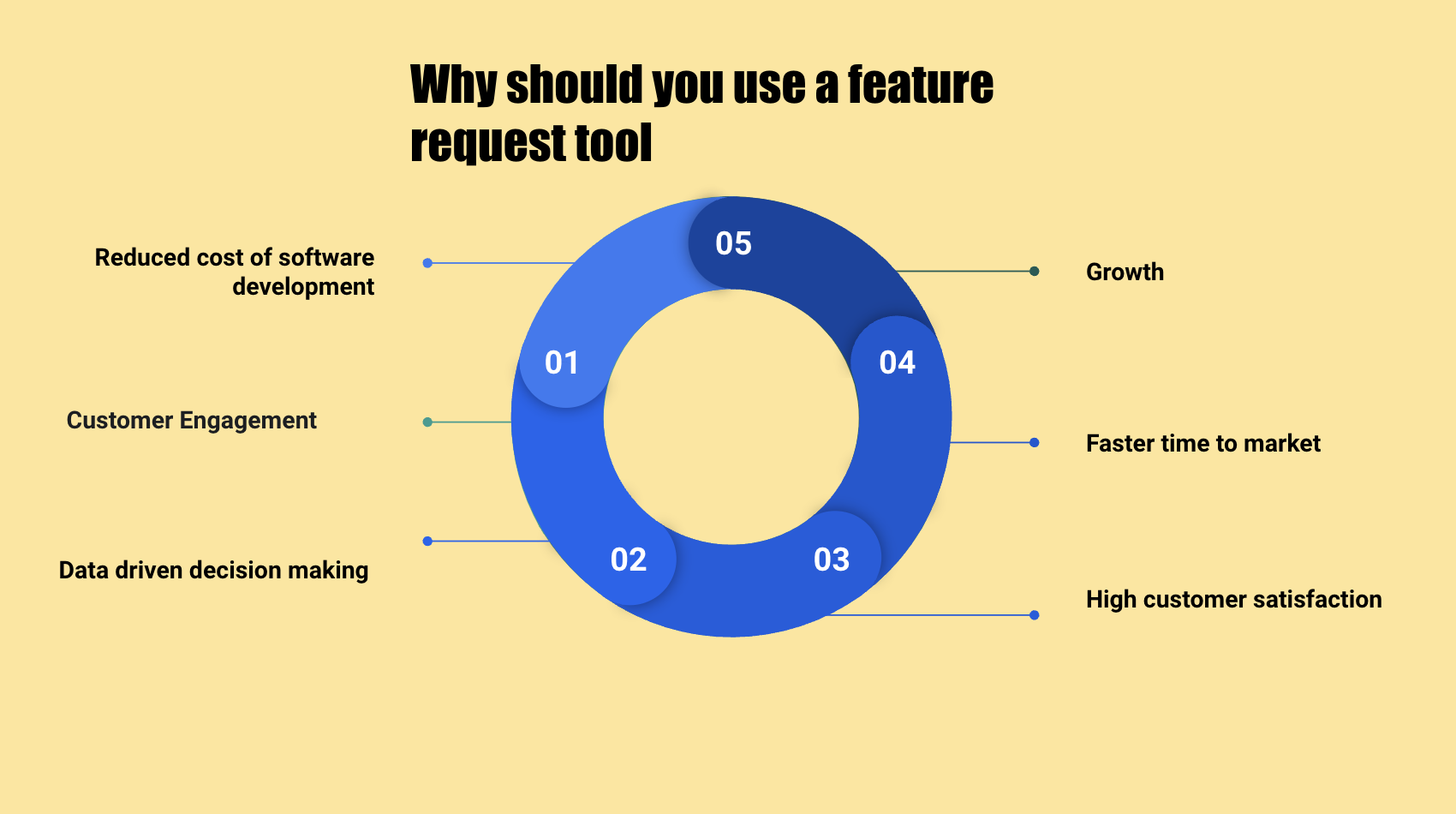 A feature request tool is a software application or platform that enables users to submit, track, and manage feature requests for a product or service. It provides a structured way for users, customers, or stakeholders to communicate their ideas and suggestions for improving a product or adding new features.
A feature request tool is a software application or platform that enables users to submit, track, and manage feature requests for a product or service. It provides a structured way for users, customers, or stakeholders to communicate their ideas and suggestions for improving a product or adding new features.
Typically, a feature request tool allows users to submit their requests through a user-friendly interface. They can provide details about the desired feature, explain its benefits, and sometimes even attach relevant files or screenshots. Once submitted, the tool organizes and categorizes the requests, making it easier for product managers or development teams to review and prioritize them.
Common features of a feature request tool
Some common features of a feature request tool include:
- Submission and tracking: Users can submit feature requests and track their status throughout the review and implementation process.
- Voting and commenting: Users can upvote or downvote feature requests to indicate their level of interest and provide comments or feedback.
- Categorization and prioritization: Feature requests can be categorized based on different criteria (e.g., functionality, urgency) and prioritized by the product team.
- Status updates: The tool allows users to receive updates on the progress of their requests, such as when they are under review, in development, or completed.
- Communication and collaboration: Users can interact with the product team, ask questions, provide additional information, and engage in discussions related to specific feature requests.
- Analytics and reporting: The tool may provide data and analytics on the most popular or requested features, allowing the product team to make data-driven decisions.
Who use feature request tools?
A feature request tool can be beneficial for a wide range of organizations and teams involved in product development. Here are some groups that can benefit from using a feature request tool:
| Who Should Use a Feature Request Tool? | Why They Use the Tool |
|---|---|
| Product Managers | To collect, prioritize, and make data-driven decisions based on customer feedback |
| Development Teams | To efficiently manage feature requests, collaborate with customers, and streamline the development process |
| Customer Support Teams | To gather and document feature requests, communicate progress, and enhance customer satisfaction |
| Marketing and Sales Teams | To gain insights into customer needs, highlight popular features, and align marketing strategies |
| User Experience (UX) Designers | To understand customer pain points, refine user interfaces, and improve the overall user experience |
| Startups and Small Businesses | To manage feature requests with limited resources, prioritize development efforts, and meet customer demands |
| Enterprise-Level Organizations | To centralize feature requests, facilitate collaboration among teams, and adopt a customer-centric approach |
How feature request tool will benefit product managers?
A feature request tool can benefit product managers in several ways:
- Centralized Feedback Management: A feature request tool provides a centralized platform for product managers to collect, organize, and manage feature requests from customers. It allows them to have a comprehensive view of customer feedback and suggestions in one place, making it easier to review, analyze, and prioritize the requests effectively.
- Prioritization and Decision Making: The tool often provides features like upvoting or voting, which allow customers to express their interest and preference for specific features. Product managers can use these metrics to gauge the popularity and demand for certain requests. This data-driven approach helps them make informed decisions when prioritizing features for development based on customer needs and business objectives.
- Efficient Workflow: A feature request tool streamlines the workflow for product managers by automating certain tasks. It eliminates the need to manually track and categorize feature requests, reducing administrative overhead. The tool may also offer features such as categorization, tagging, and status updates, enabling product managers to easily organize and track the progress of each request.
- Collaboration and Stakeholder Engagement: Feature request tools often facilitate collaboration and engagement between product managers, customers, and other stakeholders. Product managers can communicate with customers directly within the tool, seek clarifications, provide updates, and gather additional information about the requested features. This collaboration helps ensure a better understanding of customer needs, improve relationships, and build a sense of community around the product.
- Data and Insights: Many feature request tools provide analytics and reporting capabilities. Product managers can gain valuable insights into the most popular or requested features, customer preferences, and trends over time. These insights help in making data-driven decisions, aligning the product roadmap with customer expectations, and identifying areas for innovation and improvement.
- Documentation and Historical Reference: A feature request tool serves as a documented history of customer feedback and feature requests. Product managers can refer back to past requests, understand the evolution of customer needs, and track the progress and decisions made for each request. This historical reference helps in maintaining continuity, learning from past feedback, and avoiding duplication of effort.
Business impact
The table below highlights the potential impact of a feature request tool on customer retention, revenue, cost of software development, and other relevant parameters:
| Parameters | Impact with Feature Request Tool |
|---|---|
| Customer Retention | High customer satisfaction leads to improved retention |
| Revenue Generation | Customer-centric features attract new customers and increase revenue opportunities |
| Cost of Software Development | Streamlined process reduces development costs and prevents wasted effort |
| Time to Market | Prioritization based on customer feedback speeds up development and reduces time to market |
| Customer Engagement | Community engagement through the tool boosts customer involvement and loyalty |
| Product Relevance | Aligning product roadmap with customer needs improves product-market fit |
| Feedback Collection | Structured platform for collecting and managing feedback leads to better insights |
| Communication Efficiency | Centralized tool improves communication and reduces miscommunication |
| Data-Driven Decision Making | Analytics and reporting enable data-driven decision making for feature prioritization |
| Documentation | Maintaining a historical record aids in tracking and referencing past requests |
Please note that the impact of a feature request tool can vary depending on various factors such as the effectiveness of the tool, the product's target audience, and the responsiveness of the product team. This table provides a general overview of the potential impacts but may not capture the complete range of possibilities.
So, is the feature request tool right for you?
While feature request tools can bring numerous benefits to the product development process, there are situations where using such a tool may not make sense:
Small User Base: If your product has a very small user base or a limited number of customers, the overhead of implementing and maintaining a feature request tool may outweigh the benefits. In such cases, direct communication channels like emails or personal conversations may be more practical and effective for gathering feedback.
Highly Specialized Products: In some cases, products serve a highly specialized or niche market with unique requirements. In such scenarios, direct and personalized communication with customers may be more appropriate than a feature request tool. The specific needs of these customers may not align well with the standardized features and processes of a feature request tool.
Urgent and Critical Issues: If there are urgent and critical issues or bugs that need immediate attention, using a feature request tool for gathering feature requests may not be the most efficient approach. In these situations, it is often more effective to address the urgent issues promptly rather than waiting for feature requests to be processed through a tool.
Limited Resources: Implementing and managing a feature request tool requires resources, including time, personnel, and potentially additional costs. If a product team has limited resources available, it may be more practical to focus those resources on core development tasks rather than maintaining a feature request tool.
High Development Backlog: If your development backlog is already extensive and you are struggling to prioritize existing tasks, adding a feature request tool may further complicate the prioritization process. In such cases, it may be more effective to focus on the existing backlog before introducing a tool to manage additional feature requests.
Conclusion
In summary, a feature request tool streamlines the collection, management, and prioritization of customer feedback. It enables product managers to make data-driven decisions, improves collaboration within development teams, and enhances customer satisfaction. By leveraging a feature request tool, organizations can deliver customer-centric products, drive retention, and streamline software development processes.
